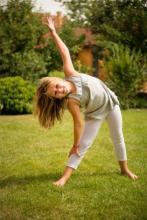
Good physical condition is how fitness is measured. Being fit occurs through healthy habits which include exercise and nutrition.1 Being physically fit offers many benefits, such as a healthy weight, strong muscles, bones, and joints, decreased risk of developing type 2 diabetes, better sleep, and a feeling of well-being.2
The National Association of Sports and Physical Education recommends that school-age children get 60 minutes of moderate to vigorous physical activity every day, divided into several segments of 15 minutes or more, if necessary, and to avoid periods of being inactive for longer than 2 hours.3
Endurance, strength, and flexibility are three elements of fitness gained through exercise. Endurance is improved with aerobic activity, which causes the heart to beat faster and the lungs to work harder. Bicycling, running, skating, and playing soccer all build endurance when the aerobic activity is sustained for continuous periods of time. Strengthening muscles can be accomplished by climbing on playground equipment, hanging from overhead ladders, and doing push-ups. Stretching exercises improve flexibility and help the muscles and joints to move easily through their full range of motion.4
Playground equipment allows a child to improve his overall fitness as he develops motor skills, such as agility, speed, balance, coordination, and power.5 Navigating the playground equipment by climbing on monkey bars, brachiating on overhead ladders, and swinging on swings all require these skills. Today’s new innovative designs with moving walkways and challenging elements encourage children to play longer on playground equipment and improve their fitness skills.
When it was reported that America’s children were less fit than European children, the President's Council on Youth Fitness was founded in 1956 to encourage American children to be healthy and active. This government organization is now known as the President’s Council on Fitness, Sports and Nutrition (PCFSN). Its mission is to educate all Americans to adopt a healthy lifestyle with regular physical activity and good nutrition.6 Children of school age receive awards from the President’s Council that offers the President’s Challenge for meeting nutrition and fitness standards. Five components of physical fitness are measured in this program: aerobic capacity, muscular strength, muscular endurance, flexibility, and body composition. Guidelines are given for the principles of exercise in the program.7
The Let’s Move! campaign, started by First Lady Michelle Obama, has set the goal of solving the challenge of childhood obesity within a generation so that children born today will reach adulthood at a healthy weight. The decrease in physical activity and lack of healthy eating has caused the childhood obesity rate in America to triple in the past 30 years with nearly one in three children being overweight or obese in America today.8
Children rarely walk to school, gym classes and recess times have decreased, and the average child spends 7.5 hours a day watching television and DVDs, playing computer and video games, and using cell phones for entertainment. Fast food, fat-filled snacks, and larger food portions add to the problem of obesity and lack of physical fitness.9
With the rising concern of childhood obesity in America, many organizations have become involved in the battle. Project Fit America is a non-profit charity that donates fully funded cardiovascular health and fitness education programs to schools.10 The Major League Baseball Players Association has joined with the Let’s Move! campaign to publicize the message to fight childhood obesity and educate the public.11 NFL Play 60 is a campaign of the National Football League designed to get children active through in-school, after school, and team-based programs.12
- 1. “Fitness.” Dictionary.com. The American Heritage Stedman’s Medical Dictionary. < http://dictionary.reference.com/browse/fitness > 5 Aug. 2010.
- 2. “Motivating Kids to Be Active.” KidsHealth from Nemours. < http://kidshealth.org/parent/nutrition_fit/fitness/active_kids.html > 5 Aug. 2010.
- 3. “Fitness and Your 6-to 12-Year-Old” KidsHealth from Nemours. < http://kidshealth.org/parent/nutrition_fit/fitness/fitness_6_12.html > 5 Aug. 2010.
- 4. “Kids and Exercise.” Kids Health from Nemours. < http://kidshealth.org/parent/nutrition_fit/fitness/exercise.html > 5 Aug. 2010.
- 5. Frost, Joe L., Pei-San Brown, John A. Sutterby, Candra D. Thornton. The Developmental Benefits of Playgrounds. Olney, MD: Association for Childhood Education International, 2004. p. 129-130.
- 6. President’s Council on Fitness, Sports and Nutrition. < http://www.fitness.gov/ > 5 Aug. 2010.
- 7. “Get Fit! A Handbook for Youth Ages 6-17.” President’s Council on Physical Fitness and Sports. < http://www.fitness.gov/publications/council/getfitandbeactive_pdf.pdf > 5 Aug. 2010.
- 8. “Learn the Facts.” Let’s Move! < http://www.letsmove.gov/learnthefacts.php> 5 Aug. 2010.
- 9. Ibid.
- 10. “Who We Are.” Project Fit America. < http://www.projectfitamerica.org/who_are_we.html > 5 Aug. 2010.
- 11. Ibid.
- 12. “NFL Play 60: The NFL Movement For An Active Generation.” National Football League. < http://www.nfl.com/news/story?id=09000d5d80b4a489&template=with-video&confirm=true > 5 Aug. 2010.

